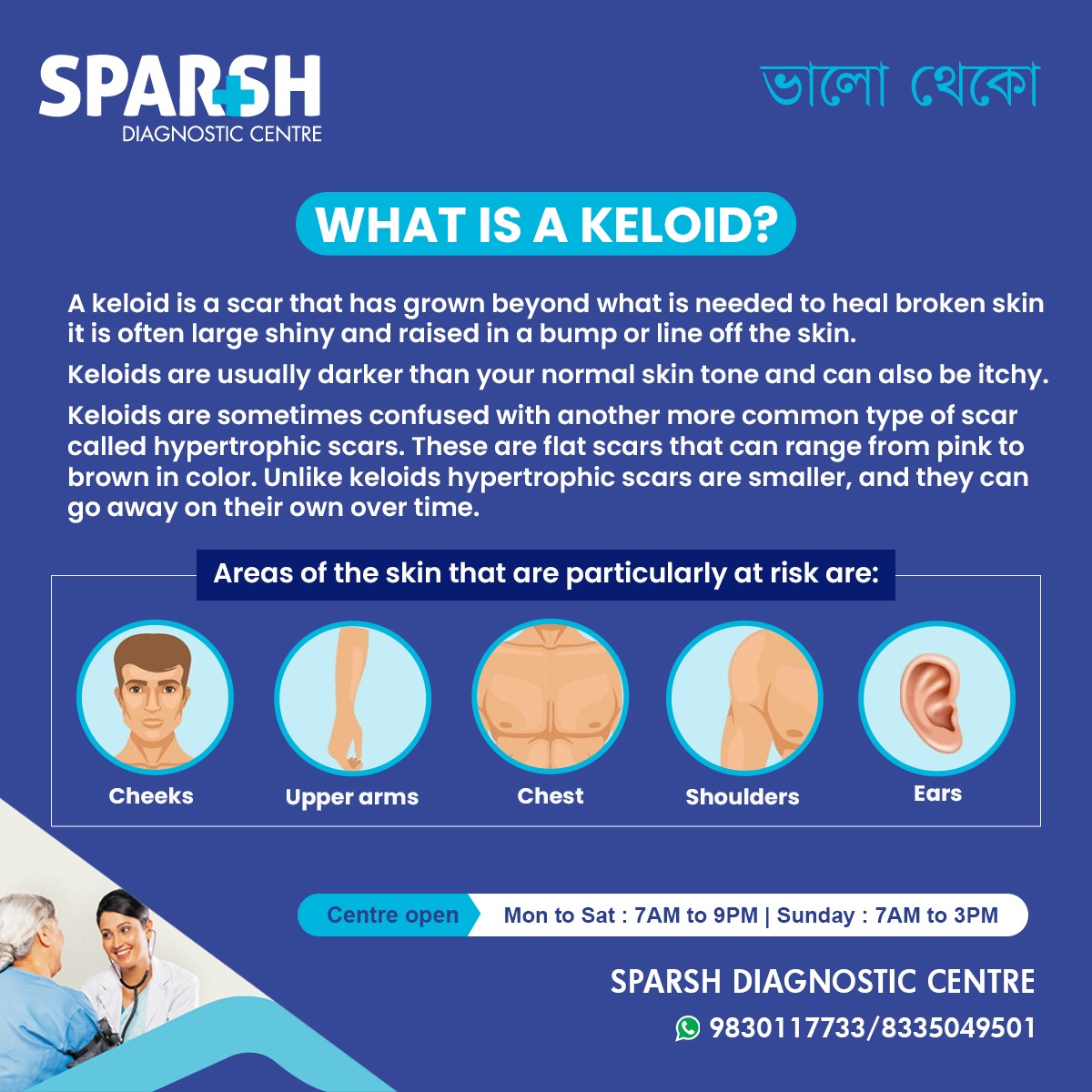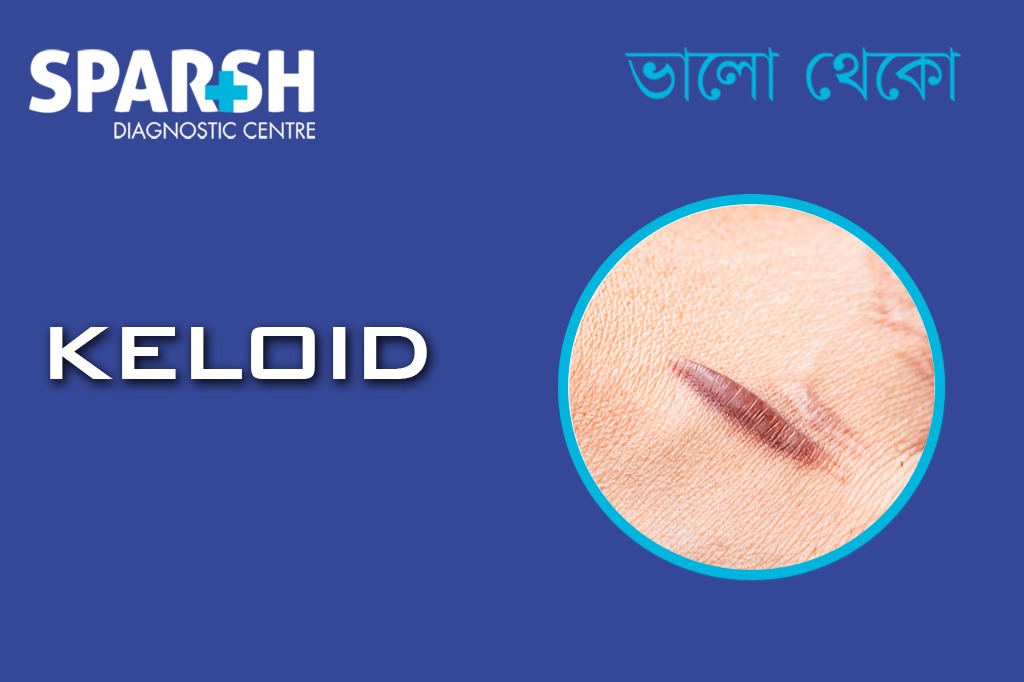A keloid is a type of scar that forms when the body’s natural healing response goes into overdrive. Instead of stopping once the skin has repaired itself, the tissue continues to grow, forming a raised, thick, and sometimes shiny scar that extends beyond the boundaries of the original wound.
While keloids are not harmful or contagious, they can cause discomfort, itching, tenderness, and cosmetic concerns. They tend to appear weeks or even months after a skin injury and can vary in color from pink to red, purple, or darker brown depending on skin tone.

How Do Keloids Form?
When your skin is injured — whether from a cut, burn, surgery, acne, piercing, or even an insect bite — your body produces collagen to repair the damage. In most people, this collagen production stops once healing is complete.
However, in individuals prone to keloids, this process doesn’t switch off properly. The body keeps producing collagen, causing the scar tissue to grow excessively, leading to a keloid.
Researchers are still studying why some people develop keloids and others don’t, but genetics and skin type play significant roles.
Areas Commonly Affected by Keloids
Keloids can appear anywhere on the body, but certain areas are more prone to them due to skin tension and frequent irritation. These include:
Cheeks
Upper arms
Chest
Shoulders
These areas tend to experience more movement or friction, making scar formation more likely.
Symptoms of Keloids
Keloids can develop slowly over time and may display several noticeable symptoms:
A raised, firm, or rubbery scar that extends beyond the original wound.
Shiny, smooth, or ridged texture.
Itchiness or tenderness.
Pain or irritation, especially when rubbed by clothing.
Changes in color — may appear pink, red, purple, or darker than surrounding skin.
Unlike hypertrophic scars, which are thick but remain within the wound boundary and may fade with time, keloids continue to grow and do not resolve spontaneously.
Who Is at Risk for Keloids?
While anyone can develop keloids, some people are more prone to them. Risk factors include:
Genetic predisposition: Family history of keloids.
Skin tone: More common in individuals with darker skin tones.
Age: Most frequent between ages 10–30.
Injury or surgery: Especially if the wound is under tension.
Body piercing or tattoos: Can trigger keloid formation on earlobes or other pierced areas.
Acne or chickenpox scars: Can sometimes result in small keloids.
Causes and Triggers
Keloids can develop after any type of skin injury, such as:
Surgical incisions
Burns
Cuts or abrasions
Vaccination sites
Piercings and tattoos
Acne scars
Insect bites
Even minor skin trauma can trigger keloid formation in predisposed individuals.
Diagnosis
A dermatologist can usually diagnose keloids by examining the scar and reviewing your medical history. In rare cases, a skin biopsy may be performed to rule out other conditions such as hypertrophic scars, dermatofibromas, or even rare skin tumors.
Treatment Options for Keloids
Treating keloids can be challenging because they have a tendency to recur. However, several effective treatment options exist to reduce their size, flatten them, and relieve symptoms.
1. Corticosteroid Injections
Corticosteroid injections (like triamcinolone) are commonly used to reduce inflammation and shrink keloids. Multiple sessions spaced a few weeks apart are usually needed.
Pros: Effective, minimally invasive.
Cons: May cause skin thinning or lightening in some cases.
2. Silicone Gel Sheets or Ointments
Silicone-based products help flatten keloids, improve their texture, and reduce redness and itching. These are applied over the scar for several hours daily over a few months.
Pros: Safe, painless, suitable for long-term use.
Cons: Requires consistent use to see results.
3. Cryotherapy
This involves freezing the keloid using liquid nitrogen to destroy excess scar tissue. It works best on small keloids and may be combined with steroid injections for better outcomes.
Pros: Reduces size and hardness.
Cons: Can cause skin lightening in darker skin tones.
4. Laser Therapy
Laser treatment helps reduce redness and flatten keloids by targeting blood vessels and promoting smoother skin regeneration.
Pros: Non-invasive and effective for cosmetic improvement.
Cons: Requires multiple sessions and can be expensive.
5. Surgical Removal
In severe cases, the keloid may be surgically removed. However, this approach must be done cautiously, as new keloids can form at the surgical site. Doctors often combine surgery with corticosteroid injections or radiation therapy to reduce recurrence.
Pros: Immediate removal of the scar tissue.
Cons: High risk of recurrence if not managed properly.
6. Radiation Therapy
Low-dose radiation therapy can be used after surgical excision to prevent regrowth. It’s reserved for stubborn or recurrent cases.
Pros: Reduces recurrence rates significantly.
Cons: Not suitable for all patients due to radiation exposure.
7. Pressure Therapy
Compression garments or earrings can help prevent keloids from forming or enlarging, especially after ear piercing or surgery.
Pros: Preventive and effective when used early.
Cons: May cause discomfort if worn for long durations.
Home Remedies and Natural Care
While medical treatment is most effective, some natural methods may help reduce discomfort and improve scar appearance:
Aloe vera: Helps moisturize and soothe the skin.
Apple cider vinegar: May reduce redness when used in diluted form.
Honey: Has natural healing and anti-inflammatory properties.
Garlic extract: May inhibit excessive fibroblast growth (use cautiously to avoid burns).
⚠️ Note: Always consult a dermatologist before trying home remedies, especially if your skin is sensitive or the scar is large.
Prevention Tips for Keloids
Preventing keloids is easier than treating them. Follow these tips to minimize your risk:
Avoid unnecessary skin trauma — like piercings, tattoos, or cosmetic surgeries if you have a history of keloids.
Treat acne promptly to prevent scarring.
Use silicone gel sheets on surgical wounds or injuries.
Follow wound care instructions carefully after surgery or injury.
Avoid scratching or picking at healing wounds.
Use sunscreen on scars to prevent discoloration and darkening.
Living with Keloids
Keloids can impact more than just your skin—they can affect self-confidence and emotional well-being, especially when visible on the face, neck, or ears.
If you’re struggling with persistent or painful scars, remember that effective treatments are available. Consulting a dermatologist at Sparsh Diagnostic Centre can help you explore safe, personalized options based on your skin type and scar condition.
When to See a Doctor
You should consult a dermatologist if:
The scar keeps growing or changing color.
You experience pain, tenderness, or itching.
The keloid restricts movement (e.g., on joints).
You want to explore treatment for cosmetic reasons.
Prompt evaluation helps ensure that the right combination therapy is chosen for best results.
Frequently Asked Questions (FAQs) About Keloids
Q1. Are they dangerous?
No, keloids are not cancerous or contagious. They are harmless but may cause discomfort or cosmetic concerns.
Q2. Can they go away on their own?
No. Unlike hypertrophic scars, keloids do not fade naturally and may continue growing if untreated.
Q3. Can I prevent keloids after surgery or piercing?
Yes. Applying silicone gel, avoiding friction, and using pressure dressings can help prevent keloids from forming.
Q4. Is laser treatment safe?
Yes, laser therapy is safe and effective when performed by a qualified dermatologist. It helps flatten scars and reduce redness.
Q5. Can they come back after removal?
Yes, recurrence is possible. Combining treatments like surgery with corticosteroids or radiation can reduce the risk.
Q6. Are keloids hereditary?
Yes. Genetics plays a significant role, and you may be more prone if your family members have them.
Q7. Do they itch or hurt?
Many people experience itching, tenderness, or mild pain, especially when the keloid is growing.
Q8. Which doctor should I see for keloids?
A dermatologist or cosmetic skin specialist is best suited to diagnose and treat keloids effectively.
Keloids are a common skin concern that can be both physically and emotionally distressing. Understanding their causes, symptoms, and treatment options is the first step toward managing them effectively.
At Sparsh Diagnostic Centre, our dermatology experts use advanced diagnostic and treatment techniques to help patients achieve smoother, healthier skin. Whether you’re seeking medical intervention or preventive advice, we’re here to help you every step of the way.
👉 Book your consultation today at:
📍 https://www.sparshdiagnostica.com/book-a-test-now/
📞 9830117733 | 8335049501
#BhaloTheko
Disclaimer:
No content on this site, regardless of date, should ever be used as a substitute for direct medical advice from your doctor or other qualified clinician.

![]()





